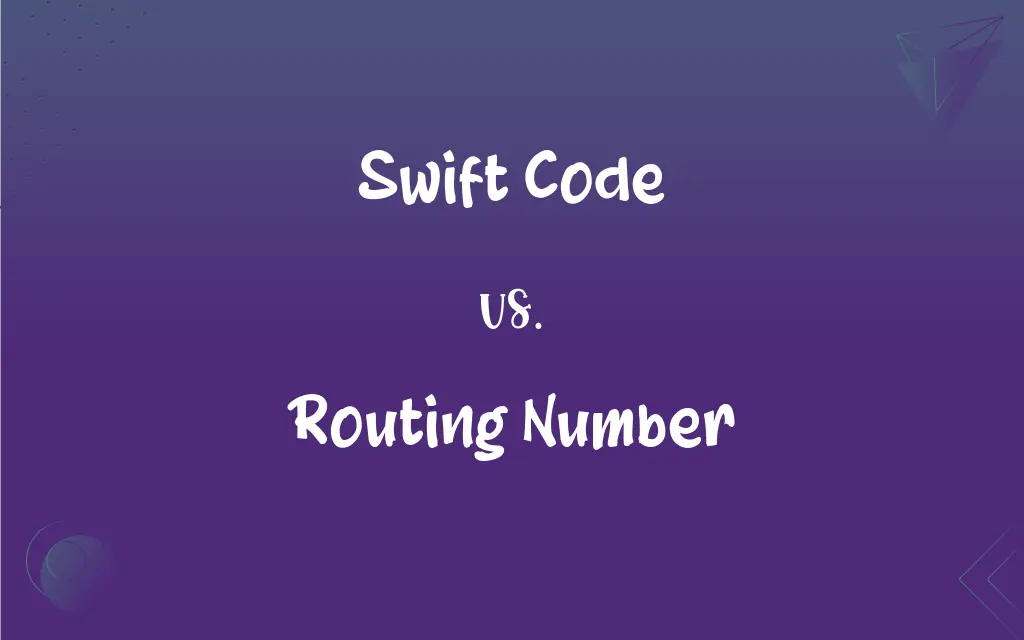Swift Code vs. Routing Number: What's the Difference?
Edited by Janet White || By Harlon Moss || Updated on June 20, 2024
SWIFT code is a global bank identifier for international transactions. Routing number is a bank identifier mainly used in the US for domestic transactions.

Key Differences
A SWIFT code is an alphanumeric code used to identify banks globally for international wire transfers and messages. While, a routing number is a nine-digit numerical code used primarily in the United States to identify financial institutions in domestic transactions.
SWIFT codes facilitate international banking communication and transactions, ensuring accuracy and security. However, a routing numbers are essential for processing domestic payments and transfers within the U.S., including direct deposits and bill payments.
Each SWIFT code is unique to a bank and often includes the bank's name, country, and branch. Whereas, routing numbers, assigned by the American Bankers Association, are unique to each U.S. bank and are used to sort and process checks and electronic transactions.
SWIFT codes are essential for cross-border transactions and are used by banks worldwide. In contrast, routing numbers are primarily used in the United States and are necessary for the Federal Reserve to process Federal payments.
The SWIFT system is a vast network of financial institutions globally, providing a standardized method for bank identification. Routing numbers, while limited to the U.S., play a crucial role in the American banking system for efficient and accurate transaction processing.
ADVERTISEMENT
Comparison Chart
Purpose
Identifies banks internationally for wire transfers
Identifies U.S. banks for domestic transactions
Length
8 or 11 characters, alphanumeric
9 digits, numerical
Usage
International transactions and messaging
Domestic transactions, including check processing
Region
Global, used by banks worldwide
United States, for domestic banking
Format
Includes bank, country, location, branch
Unique to each bank, assigned by American Bankers Association
ADVERTISEMENT
Swift Code and Routing Number Definitions
Swift Code
A global bank identifier for international transactions.
The SWIFT code is required for sending money overseas.
Routing Number
Used by the Federal Reserve for processing Federal payments.
The routing number ensured her tax refund was deposited correctly.
Swift Code
An alphanumeric code representing a bank in international wires.
Her bank's SWIFT code ensured her tuition was sent to the correct university abroad.
Routing Number
Used for domestic transactions within the United States.
His check's routing number directed the payment to the right bank.
Swift Code
Essential for international bank communication and transfers.
The company used the SWIFT code for its overseas supplier payments.
Routing Number
A nine-digit number identifying U.S. financial institutions.
The routing number was required for setting up her direct deposit.
Swift Code
Unique to each bank, often includes bank and country information.
The SWIFT code BKBKINBBXXX represents a specific bank in India.
Routing Number
Essential for processing checks and electronic payments in the U.S.
The online payment system asked for the bank's routing number.
Swift Code
Used in cross-border banking and financial messaging.
He needed the SWIFT code to receive an international wire transfer.
Routing Number
Assigned by the American Bankers Association to each bank.
Each branch of her bank had its own unique routing number.
FAQs
Are SWIFT codes and routing numbers the same?
No, SWIFT codes are used for international transactions, while routing numbers are for domestic U.S. transactions.
How many digits are in a SWIFT code?
SWIFT codes are 8 or 11 characters long, alphanumeric.
What is a SWIFT code?
A SWIFT code is an international bank code used for identifying banks in cross-border transactions.
Do all banks have a SWIFT code?
Most international banks have SWIFT codes, but not all smaller or local banks do.
Can I find my bank's SWIFT code online?
Yes, most banks list their SWIFT codes on their websites or can be found through online searches.
Where is my routing number located?
Routing numbers are typically found on checks or can be obtained from your bank.
What is a routing number?
A routing number is a nine-digit code used to identify U.S. banks in domestic transactions.
How many digits are in a routing number?
Routing numbers are always nine digits.
Do I need a SWIFT code for domestic transfers?
No, SWIFT codes are only for international transactions.
Are routing numbers the same for all branches of a bank?
No, some banks have different routing numbers for different branches or regions.
How do I find a bank's SWIFT code for an international transfer?
You can find it on the bank's website, on your bank statement, or by contacting the bank directly.
Do credit unions have routing numbers?
Yes, credit unions in the U.S. also have routing numbers.
Is a routing number needed for international wire transfers?
No, for international transfers, a SWIFT code is required, not a routing number.
Can I use a SWIFT code for a domestic transfer in the U.S.?
It's not necessary; domestic transfers typically require only a routing number.
Can a bank have multiple routing numbers?
Yes, especially larger banks may have different routing numbers for different purposes or regions.
Is the SWIFT code used in all countries?
Most countries participate in the SWIFT network, but some may use different systems.
How secure is the SWIFT network?
The SWIFT network is highly secure and is the standard for international banking communication.
Are routing numbers used internationally?
No, routing numbers are specific to the U.S. banking system.
Is a routing number required for setting up direct deposit?
Yes, a routing number is needed to set up direct deposit in the U.S.
Is the SWIFT code the same as an IBAN?
No, the SWIFT code identifies the bank, while an IBAN (International Bank Account Number) identifies an individual account.
About Author
Written by
Harlon MossHarlon is a seasoned quality moderator and accomplished content writer for Difference Wiki. An alumnus of the prestigious University of California, he earned his degree in Computer Science. Leveraging his academic background, Harlon brings a meticulous and informed perspective to his work, ensuring content accuracy and excellence.
Edited by
Janet WhiteJanet White has been an esteemed writer and blogger for Difference Wiki. Holding a Master's degree in Science and Medical Journalism from the prestigious Boston University, she has consistently demonstrated her expertise and passion for her field. When she's not immersed in her work, Janet relishes her time exercising, delving into a good book, and cherishing moments with friends and family.































































